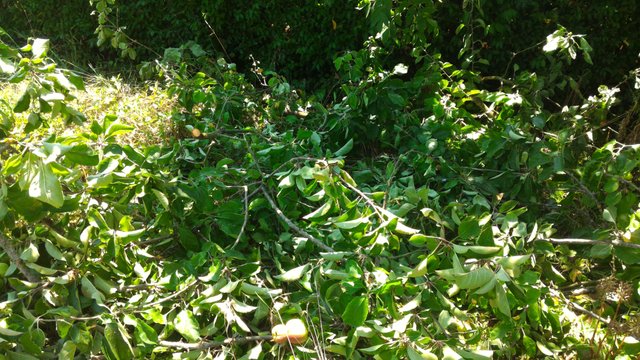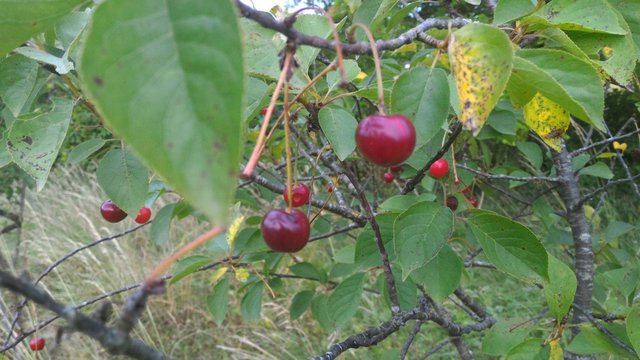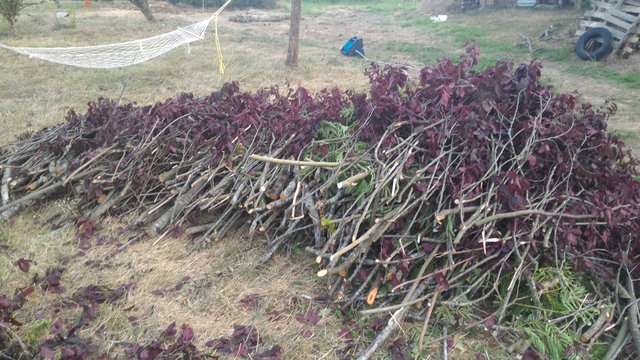This is the second part of a series of posts showing what we’ve done with the garden so far. Check out Part 1 here.
Permaculture is all about accelerating nature’s processes. We are keen to use as much of the resources available on our land, minimizing external inputs. It feels like an elegant closed system if you can mulch your garden with its own leavings, just as you might feed chickens your kitchen scraps, or irrigate with caught rainwater. All of this builds self-sufficiency and sustainability into your system.
So we’d already laid some foundations with the hugelkulturs, but looking around at the trees, the grass not yet fully cut, hedges straining skyward, and stands of weeds encroaching, it was still a daunting task. But we also saw resources.
On the back edge of the garden there is a large pine tree, two oaks, and a hazelnut. A couple of smaller oaks and a beaten up old plum tree are interspersed with the hedges along the roadside, the eastern edge. In the western half of the garden are some fruit trees.

We’d brutalized a few of the trees in October last year with the help of a mate, taking some of the trees down to a manageable size and trimming off broken branches. But I knew they needed a good going over, especially the fruit trees. The garden is dominated by a glorious cherry plum in its centre, and an apple tree on its western edge. We got apples in October. In fact, not only did we get apples but there was also a thick carpet of them on the ground that not only composted back to the soil there, but gave us a few barrow loads to lay down where the hugelkulturs now live.

The cherry tree had already fruited and the birds apparently enjoyed them before we arrived. So I was surprised when standing beneath the cherry plum I glanced up and spotted the juicy fruits dangling almost camouflaged among the rich maroon foliage. Plenty were hanging low enough to pick, and the tree was so thick with fruit that when word got out to the local bird population there were still plenty for us to collect in the lower branches while they foraged higher up in the tree.

Behind the cherry plum, on either side of the cherry tree is a row of hibiscus trees. They are all slightly different with different coloured flowers. Interestingly they all flowered at slightly different times, so the bees were busy in the hibiscus almost the whole six weeks we were there.

As we were tidying up the garden, we kept finding sticks on the ground among the thick grass. They were often in little mounds of grass, and a little digging beneath uncovered more and more of them. Most were from our hasty pruning last year, where we’d just left them in what we thought were neat piles. This shows the value of having even the smallest material on the ground. I’m not sure how much of it is organic material being watered in with the rain, how much is just the benefit of a little bit of shade, probably both, but it was an interesting experiment even if by accident.

What these grass-covered sticks also showed is that it pays be neat and prepared. Put your resources where you want them to end up. Nature never stops working, and it doesn’t mind working around the obstacles you put in the way.
Some of the early prunings and these collected sticks went into the hugelkulturs, along with some overgrown and tangled rose bushes and grapevines along the front wall.
As we were cutting back the trees we were still identifying them – learning to pick out trees by leaf shape and flower. We were continually surprised as we took stock of the fruit trees.
There are two pear trees, a plum, and a nectarine. A smaller cherry tree that is probably a sour cherry. Another small apple tree, a goldrush if the tag is to be believed. We also have a fig tree alongside the little outbuilding that is currently a woodshed, and will eventually become a chicken coop.

Not the best time of year for pruning, admittedly. Ideally we’d be pruning well after summer, letting them fruit and run their course to winter. We probably set them back a Jpeglittle, but the idea was always to start shaping them and clearing them out for when we move. Better that they have a couple of quiet years now than when we move.
There was also lichen growing on most of the smaller trees, which told us there was significant humidity. This might just be the natural condition of the area, but it was no doubt accelerated by the bushiness of the trees not allowing enough light through.

As the space and light opened up, we could see better what space we had. It all felt more open. With a little judicious spacing we reckon we can fit at least 10-12 more fruit trees in the garden, but that will happen over time.
We piled up the cut branches in one pile, and the smaller sticks and leaves in another. The picture below shows what we collected off half a dozen trees. There were still the large trees bordering the garden, the hedges, and more trees out behind the house along the river to be trimmed.

What to do with all that wood? We could only have so many barbecues. More hugelkulturs? The fruit trees needed mulching, and a few more garden beds would be ideal. And we had our eyes on a woodchipper…
Stay tuned for the next installment of the Auberge garden preparation!